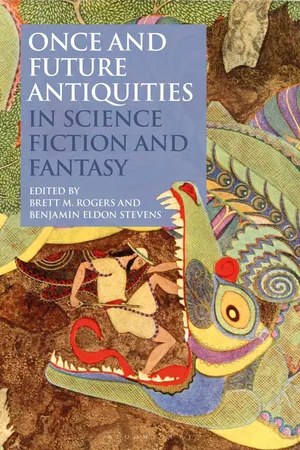
Once and Future Antiquities in Science Fiction and Fantasy
- 248 pages
- English
- ePUB (mobile friendly)
- Available on iOS & Android
Once and Future Antiquities in Science Fiction and Fantasy
About this book
In 15 all-new essays, this volume explores how science fiction and fantasy draw on materials from ancient Greece and Rome, 'displacing' them from their original settings-in time and space, in points of origins and genre-and encouraging readers to consider similar 'displacements' in the modern world. Modern examples from a wide range of media and genres-including Philip Pullman's His Dark Materials and the novels of Helen Oyeyemi, the Rocky Horror Picture Show and Hayao Miyazaki's Spirited Away, and the role-playing games Dungeons and Dragons and Warhammer 40K- are brought alongside episodes from ancient myth, important moments from history, and more. All together, these multifaceted studies add to our understanding of how science fiction and fantasy form important areas of classical reception, not only transmitting but also transmuting images of antiquity. The volume concludes with an inspiring personal reflection from the New York Times-bestselling author of speculative fiction, Catherynne M. Valente, offering her perspective on the limitless potential of the classical world to resonate with experience today.
Frequently asked questions
- Essential is ideal for learners and professionals who enjoy exploring a wide range of subjects. Access the Essential Library with 800,000+ trusted titles and best-sellers across business, personal growth, and the humanities. Includes unlimited reading time and Standard Read Aloud voice.
- Complete: Perfect for advanced learners and researchers needing full, unrestricted access. Unlock 1.4M+ books across hundreds of subjects, including academic and specialized titles. The Complete Plan also includes advanced features like Premium Read Aloud and Research Assistant.
Please note we cannot support devices running on iOS 13 and Android 7 or earlier. Learn more about using the app.
Information
PART I
DISPLACING POINTS OF ORIGIN
CHAPTER 1
MORE ‘T’ VICAR? REVISITING MODELS AND METHODOLOGIES FOR CLASSICAL RECEPTIONS IN SCIENCE FICTION
Revisiting the original post
Table of contents
- Cover
- Half-Title Page
- Series Page
- Title Page
- Contents
- List of Illustrations
- Notes on Contributors
- Preface
- Introduction: Displacing Antiquities in Science Fiction and Fantasy Brett M. Rogers and Benjamin Eldon Stevens
- Part I: Displacing Points of Origin
- 1 More ‘T’ Vicar? Revisiting Models and Methodologies for Classical Receptions in Science Fiction Tony Keen
- 2 Saxa loquuntur? Archaeological Fantasies in Wilhelm Jensen’s Gradiva Jesse Weiner
- 3 Time Travel and Self-Reflexivity in Receptions of Homer’s Iliad Claire Kenward
- 4 Monuments and Tradition in Jack McDevitt’s The Engines of God Laura Zientek
- Part II: Displaced in Space
- 5 Lyra’s Odyssey in Philip Pullman’s His Dark Materials Trilogy Ortwin Knorr
- 6 Displacing Nostos and the Ancient Greek Hero in Hayao Miyazaki’s Spirited Away Suzanne Lye
- 7 “The Nearest Technically Impossible Thing”: Classical Receptions in Helen Oyeyemi Benjamin Eldon Stevens
- Part III: Displaced in Time
- 8 Dynamic Tensions: The Figure(s) of Atlas in The Rocky Horror Picture Show Stephen B. Moses and Brett M. Rogers
- 9 Drinking Blood and Talking Ghosts in Diana Wynne Jones’s The Time of the Ghost Frances Foster
- 10 Finding Cassandra in Science Fiction: The Seer of Agamemnon and the Time-Travelling Protector of Continuum Jennifer C. Ranck
- Part IV: Displacing Genre
- 11 Classical Reception and the Half-Elf Cleric C. W. Marshall
- 12 The Gods Problem in Gene Wolfe’s Soldier of the Mist Vincent Tomasso
- 13 The Divine Emperor in Virgil’s Aeneid and the Warhammer 40K Universe Alex McAuley
- Part V: Epilogue: Finding a Place in Displacement
- 14 Just Your Average Tuesday-Morning Minotaur Catherynne M. Valente
- Works Cited
- Index
- Copyright